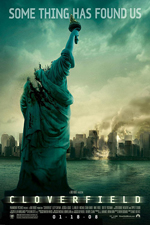 Released: 2008
Released: 2008
Starring: Lizzy Caplan, Jessica Lucas, T.J. Miller, Michael Stahl-David, Mike Vogel, Odette Yustman
Director: Matt Reeves
Distributed by: Paramount Pictures
“run. fast.”
With the third Cloverfield movie, The Cloverfield Paradox, suddenly dropping on Netflix just hours after it’s announcement during the Super Bowl and the fourth one already planned for an October theatrical release, it seems like a perfect time to look back on this history of this topsy-turvy saga. Over the next few weeks, I’m going look at each of the Cloverfield movies, reviewing them largely as individual films (as they were each originally filmed), but also delving a bit into how they fit into the overarching universe viewers are still puzzling over. This week, we’re focusing on the original Cloverfield movie, 10 years after its release.
While the found footage genre, and specifically the horror subset of it, has been around since 1980 and was largely popularized in 1999 by The Blair Witch Project, Cloverfield is still one of the most iconic found footage films and is a major influence on the 100+ films in the genre that have released in the last decade. We experience a single night largely from the perspective of Hud (T.J. Miller, Silicon Valley) who originally was placed in charge of the camcorder in order to take testimonials during his best friend, Rob’s (Michael Stahl-David, Narcos), farewell party. As tension rises between the party guests there is a sudden tremor that seems to rock all of Manhattan. Understandably, people immediately worry about another attack similar to 9/11 and begin following directions to evacuate across the bridge into Brooklyn. Along the way they try to piece together what’s going on, witnessing widespread destruction while catching only brief glimpses of the cause. Hud clings to the camcorder, offering a convenient lens for the audience to be pulled into the action as well as symbolizing the last shred of normalcy the character’s hold on to as the city falls apart around them. As long as Hud keeps filming, as long as he continues to document what’s happening, he has a purpose and a way to try to distance himself from the chaos.
Each character has their own cause that they cling to in order to get themselves through this experience, because it’s impossible to process what’s going on and still continue to function enough to find a way to survive. Rob needs to find Beth (Odette Annable, Supergirl), the friend he has always loved who is trapped in her midtown apartment. Rob’s brother, Jason (Mike Vogel, Under the Dome and The Brave), is just trying to get everyone to safety. Lily (Jessica Lucas, Gotham and Evil Dead), Jason’s girlfriend, wants to keep everyone together, mainly watching out for her friend Marlena (Lizzy Caplan, Masters of Sex and Hot Tub Time Machine) who was injured early in the film.
Characters in horror movies everywhere are notorious for making the worst choices imaginable and often the crew in Cloverfield is no different, yet the unwavering determination they have to continue filling their respective roles doesn’t leave you shouting at the screen “Why are you going down the creepy stairwell?! It is literally oozing evil and darkness!” like many other movies. Their actions are coping mechanisms people instinctively understand, a feeling that is accomplished by the found footage perspective.
There are no quiet moments where these characters feel like the danger has passed and begin to let their guard down. The tension is palpable in their voices and the actions they take when they don’t realize the camera can see them, whether it’s freezing up and staring into the middle distance or just moving for the sake of moving in small, frantic motions. The audience is on the ground with them, maybe catching glimpses of things in the background the characters themselves might not be noticing, but beyond that restrained by the same limited perspective anyone would have in this situation. While this cinematography style may have devolved into a trope by this point, when Cloverfield first came out it still felt fresh and unexplored, especially for the new generation of horror fans. It’s not just a gimmick, but a way to uniquely capture a sense of empathy for these characters and their experiences you might not be able to feel as fully from further away with long cuts of monsters rampaging the city at large. Producer J.J. Abrams (Star Trek, Star Wars, Lost) is notorious for his big-budget special effects. While there might be plenty of explosions going off around us, they don’t distract from the characters themselves because, much like the monsters/aliens/who knows what, you rarely get a clear glimpse of them happening—only what they leave behind.
While each film in this series has many unique attributes I’m going to be exploring, this feeling of closeness to the characters and their perspective from the original Cloverfield sets a tone for everything that is to follow. There are things happening around them, things they can’t fully understand, so instead the focus remains on what they can try to figure out and accomplish. Certainly, this leaves many questions about the greater universe of the films and who knows if there will be any satisfying answers to be found, but that’s for another time.
Rating:
Steph:
Cloverfield is one of those movies I feel like I started to appreciate more the more I thought about it for this review. Just sitting down and watching it is entertaining, but actually delving in deep (as with most forms of media) is the truly exciting part. I’m looking forward to seeing where my exploration of the other two films goes.




Fool on the Hill:
Cloverfield was revolutionary in the ‘found-footage’ horror film genre. It’s never-ending in it’s action, the plot moved along fairly well, and the audience is able to become attached to the characters with the little bit of backstory given. Because it happens mostly in real-time, there are some slower parts, and the movie does well to remind you that everyone involved (the characters AND the audience) have no idea what’s going on until the villain is revealed near the end. For some people, this movie may be dizzying to watch, and some might be frustrated with the lack of information presented throughout, but there aren’t many films like it out there. If you are a fan of found-footage film, this is a must-see! But watching it once was enough for me.



Leave a Reply